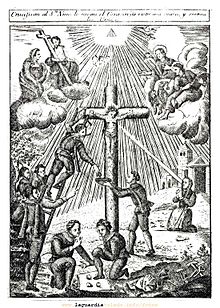
Back Светото дете от Ла Гуардия Bulgarian Sant Nen de La Guardia Catalan Santo Niño de La Guardia Spanish Affaire du Saint Enfant de La Guardia French Niño de La Guardia Italian La Guardialı Kutsal Çocuk Turkish Ігнатій з Ла Гардії Ukrainian
Holy Child of La Guardia | |
|---|---|
 An engraving with the martyrdom of the Holy Child of La Guardia | |
| Died | Good Friday, 1491 |
| Venerated in | Folk Catholicism |
| Major shrine | Monastery of St. Thomas of Avila, La Guardia, Spain |
| Controversy | blood libel |
The Holy Child of La Guardia (Spanish: El Santo Niño de La Guardia) is a folk saint in Spanish Roman Catholicism and the subject of a medieval blood libel in the town of La Guardia in the central Spanish province of Toledo (Castile–La Mancha).[1][2]
On 16 November 1491 an auto-da-fé was held outside of Ávila that ended in the public execution of several Jews and conversos. The suspects had confessed under torture to murdering a child. Among the executed were Benito García, the converso who initially confessed to the murder.[3] However, no body was ever found and there is no evidence that a child disappeared or was killed; because of contradictory confessions, the court had trouble coherently depicting how events possibly took place.[4] The child's very existence is also disputed.[5]
Like Pedro de Arbués, the Holy Infant was quickly made into a saint by popular acclaim, and his death greatly assisted the Spanish Inquisition and its Inquisitor General, Tomás de Torquemada, in their campaign against heresy and crypto-Judaism. The cult of the Holy Infant is still celebrated in La Guardia.
The Holy Child has been called Spain's "most infamous case of blood libel".[6] The incident took place one year before the expulsion of the Jews from Spain,[6] and the Holy Child was possibly used as a pretext for the expulsion.[2]
In 2015, the Archdiocese of Madrid's official website published an article describing the Holy Child as a "martyr" and asserting that the events as described had actually taken place. As of 2023, the article is still online.[7]
- ^ La Guardian, Holy Child of, Encyclopaedia Judaica.
- ^ a b Robert Michael, A History of Catholic Antisemitism: The Dark Side of the Church (Palgrave Macmillan, 2008), p. 70.
- ^ Reston, James: "Dogs of Gods: Columbus, the Inquisition, and the defeat of the Moors", p. 207. Doubleday, 2005. ISBN 0-385-50848-4
- ^ Smelik, Klaas: "Herleefde Tijd: Een Joodse Geschiedenis", p. 198. Acco, 2004. ISBN 90-334-5508-0
- ^ Salomons, Carolyn (2017). "A Church United in Itself: Hernando de Talavera and the Religious Culture of Fifteenth-Century Castile". The Catholic Historical Review. 103 (4): 639. doi:10.1353/cat.2017.0158. S2CID 158333823.
- ^ a b Irene Silverblatt, "New Christians and New World Fears in Seventeenth-Century Peru" in From the Margins: Historical Anthropology and Its Futures (Duke University Press, 1998: ed. Brian Keith Axel), p. 98.
- ^ El Santo Niño de La Guardia, mártir († 1489)
© MMXXIII Rich X Search. We shall prevail. All rights reserved. Rich X Search